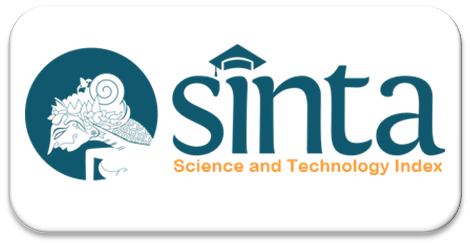Hubungan Lama Mobilisasi Aktif Dengan Penurunan Resiko Terjadinya Komplikasi Luka Pada Pasien Post Sectio Cesaria (Sc) Di Rsud Dr.R.Goeteng Taroenadibrata Purbalingga
Abstract
Background : Treatment given to post SC patients is aimed for preventing the risk of wound complication after the surgery. And one of the prevention is by conducting mobilisation which is hoped for improving the blood distribution so that the wound recovery process can occur faster.
Purpose :This research was aimed for knowing the correlation between the length of active mobilisation and the decreasing of the risks of wound complication of post SC patients at Goeteng Hospital, Purbalingga.
Method : This reseach used analytic observation technique with cross sectional approach. The samples were taken using purposive sampling technique. The respondents were 36 post SC patients. The data were taken in three-day active mobilisation treatment after the surgery.
Result : The result of the research was that the average length of time of active mobilisation was in enough category (120-140 minutes). Of the 8 respondents had wound complications, whereas 28 respondents did not experience wound complications. The correlation between the length of active mobilisation and the decreasing of the risks of wound complication of post SC patients has a p value = 0.003, which means that the value of p is ≤ 0.05, and the X2 count is 11.700 and also the X2 tabel is 5.591.
Conclusion : The result showed that there was correlation between the length of active mobilisation and the decreasing of the risks of wound complication of post SC patients at Goeteng Hospital, Purbalingga.
Key words; active mobilisation, wound complication risk, post SC.
References
Arikunto, S (2002). Prosedur Penelitian Suatu Pendekatan Praktek. Edisi revisi V. Jakarta: Rineka Cipta.
Arikunto, S. (2006). Prosedur penelitian : suatu pendekatan praktek. Jakarta: Rineka Cipta.
Akhrita, Z.,(2011) Pengaruh Mobilisasi Dini Terhadap Pemulihan Kandung Kemih Pasca Pembedahan Dengan Anestesi Spinal Di IRNA B. Skripsi, Universitas Andalas : Fakultas Kedokteran
Ayello, E. A. (2006). Klien dengan Luka. In P. A. Potter & A. G. Perry (Eds), Buku Ajar Fundamental Keperawatan (4ed., Brunner & Suddart.,(2002). Buku Ajar Keperawatan Medikal Bedah. Jakarta : EGC Vol.2). Jakarta: EGC.
Azzawi, F., (2002). Atlas Teknik Kebidanan.Jakarta: EGC
Bariah, K. (2010). Efektifitas Mobilisasi Dini Terhadap Proses Penyembuhan Luka Seksio Cesarea. Universitas Sumatera Utara. Medan.
Barid, M.(2011). Pengaruh Mobilisasi dini terhadap Proses Penyembuhan Luka dan lama Hari Rawat Pada Pasien Post pembedahan Sectio Caesarea Di Ruang Brawijaya Kanjuruhan Malang.Universitas Brawijaya, Malang.
Brown, D., L. (2004). Wound, Michigan Manual of Plastic Surgery, 1st ed. Philadelphia: Lippincott Williams & Wilkins.
Brunner & Suddart.,(2002). Buku Ajar Keperawatan Medikal Bedah. Jakarta : EGC
Bobak, Lowdermilk, Jensen. (2005). Buku Ajar Keperawatan Maternitas edisi 4. EGC, Jakarta.
Carpenito. (2000). Diagnosa Keperawatan : Aplikasi Praktek Klinis. EGC : Jakarta
Cunningham, (2006). Obstetri Willams. Volume I, EGC, Jakarta
Fawzy, M., Zalata, K. (2010). Late post-Cesarean surgical complication. Journal of Obstetric and Gynecology and Pathology. Res. Vol. 36, No. 3: 544-549
Fitriyahsari, (2009). Kebutuhan Dasar Manusia. Jakarta:EGC
Forbeterhealth. Membantu pasien Bergerak.
http : //forbetterhealth. Wordpress.Com
Gallagher, C.M. (2004). Pemulihan Pasca operasi Caesar. Jakarta : Erlangga.
Hamilton, (2008). Masa Kehamilan dan Persalinan, Jakarta : PT. Elex Media Komputindo kelompok Gramedia.
Hayati, (2010). Faktor-faktor Yang berhubungan Dengan Penyembuhan Luka Pasca Operasi Di Irna Bedah RSUP DR. Djamil Padang Tahun 2010. Skripsi, Universitas Andalas Padang.
Henriati, (2010). Gambaran Faktor- Faktor Yang Mempengaruhi Mobilisasi Dini Pada Ibu Post Partum Seksio Sesarea, Karya Ilmiah, Universitas Sumatra
Utara: Medan
Hidayat, A,A (2007), Metode penelitian keperawatan dan teknik analisa data, Salemba Medika, Jakarta.
Hidayat, A.,(2010). Metode Penelitian Kesehatan ; Paradigma Kuantitatif. Edisi Pertama. Salemba, Surabaya.
Kartinah, (2009). Mekanisme Penyembuhan Luka. KDM 2006. Keperawatan, SI, FIK, UMS.
Kasdu, (2003). Buku Ajar Medikal Bedah. Jogjakarta: Graha ILmu
Kozier. (2004). Fundamental of Nursing Concepts Process and Practice. New Jersey. Inc. Sedney River
Kurniawan, A. (2010). Hubungan Lama Waktu Mobilisasi Aktif Terhadap Penurunan Resiko Terjadinya Komplikasi Luka Pada pasien Post Prostatectomy Di Rumah sakit Margono Soekarjo Purwokerto. Skripsi, Universitas jenderal Soedirman, Purwokerto. (Tidak dipublikasikan)
Manuaba, I. B., (2002) Ilmu Kebidanan, penyakit Kandungan, dan Keluarga Berencana untuk Pendidikan Bidan. Jakarta : EGC
Manuaba, Ida Bagus Gde. (2010). Ilmu Kebidanan, Penyakit Kandungan, dan KB.
Jakarta: EGC.
Mitayani. (2009). Asuhan Keperawatan Maternitas. Salemba Medika : Jakarta
Mochtar, R., ( 2005). Sinopsis Obstetric. Jakarta: EGC Liu, D., 2008. Manual Persalinan. Jakarta: EGC
Mundy, C.,( 2005). Pemulihan Pasca Operasi Caesar. Erlangga: PT Gelora Aksara Pratama.
Muttaqin Arif, (2009). Asuhan keperawatan perioperatif, EGC, Jakarta
Notoadmodjo. (2010). Metodologi penelitian kesehatan. Jakarta: Rineka Cipta.
Novitasari, A (2011) Hubungan Motivasi Pasien dengan Pelaksanaan Mobilisasi Dini Pasca Secsio Sesarea di RSU Mitra Sejati Medan. SkripsiUniversitas Sumatera Utara, Medan.
Nursalam. (2003). Pendekatan praktis metodologi riset keperawatan. Jakarta: CV Sagung Seto.
Potter & Perry. (2005). Buku Ajar Fundamental Keperawatan. EGC : Jakarta
Resha, (2010). Pengantar Perilaku Manusia. Jakarta: EGC
Roper. (2002). Prinsip-prinsip keperawatan. Yayasan Essential Medica : Yogyakarta
Santjaka, A.( 2008). Biostastistik. Global Internusa : Purwokerto
Saifudin B. A., Adrianz G., dkk, (2009). Buku Acuan Nasional Pelayanan Kesehatan Maternal dan Neonatal edisi 1. YBP-SP, Jakarta.
Santosa, D. (2008). Efektifitas Gentamisin Anestesi dan Iodine Povidone 10 % Terhadap Penyembuhan Luka Post Operasi Laparatomi Di RSUD Purbalingga. Skripsi, Universitas jenderal Soedirman, Purwokerto. (Tidak dipublikasikan)
Saryono. (2011). Metodologi penelitian keperawatan. Purwokerto: UPT. Percetakan dan Penerbitan Universitas Jenderal Soedirman.
Smeltzer, suzanna C, (2002). Buku Ajar Keperawatan Medikal Bedah. Brunner & Suddart edisi 8 volume 1,2,3. EGC, Jakarta.
Sjamsuhidayat, R., De Jong, W, (2011). Buku Ajar Ilmu Bedah edisi 3. Jakarta: EGC
Sulastri, (2012). Hubungan Kadar Hemoglobin dengan penyembuhan luka Post Sectio Caesarea (SC) di Ruang Mawar I RSUD DR. Moerwadi Surakarta. Skripsi.
Sugiyono. (2009). Statistika untuk penelitian. Bandung: Alfabeta.
Suriadi. (2004). Perawatan Luka, edisi 1, CV Sagung Seto, Jakarta
Torre, J., D., L., Sholar, A ( 2006). Wound Healing, Chronic Wounds. e-Medicine from WebMD http://www.emedicine.com/plastic/topic 477.htm
Winjosastro. (2007). Ilmu Bedah kebidanan. Yayasan Bina Pustaka Prawirohardjo, Jakarta.
Downloads
Published
How to Cite
Issue
Section
License
Submitted paper will be firstly reviewed by the editors to determine whether the paper meet the edition theme and submission guidelines. Papers which meet the theme and the guidelines will be assigned to selected reviewers for peer-reviews. Viva Medika: Jurnal Kesehatan, Kebidanan dan Keperawatan is a double blind peer-reviewed journal which involves reviewers based on their experties relevant to the topic of the paper. Final decision of paper acceptance is solely decided by the editors according to reviewers' comment.
Plagiarism and self-plagiarism are prohibited. Viva Medika: Jurnal Kesehatan, Kebidanan dan Keperawatan uses PlagiarismCheckerX and iThenticate to scan papers for detecting plagiarism. Thus, Appropriate citation and quotation should be used

.png)








